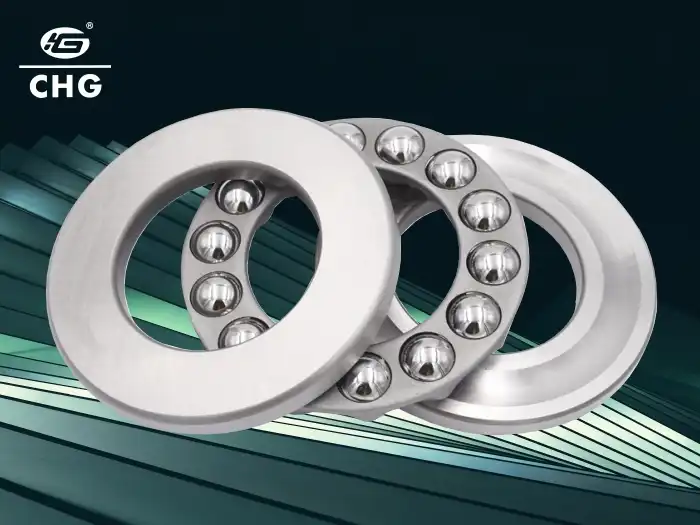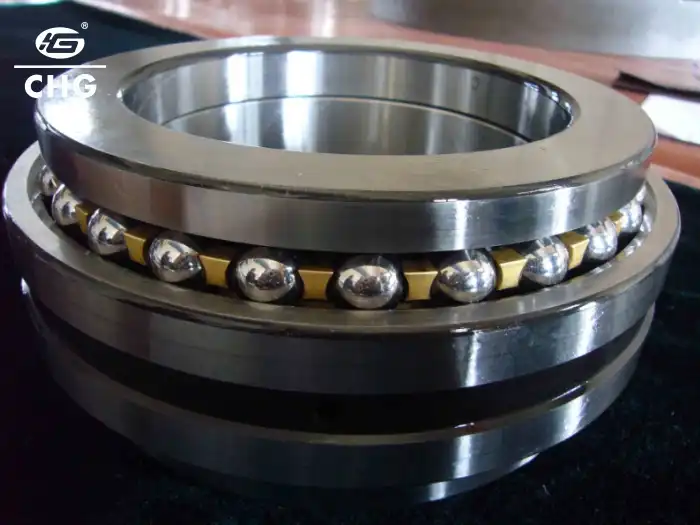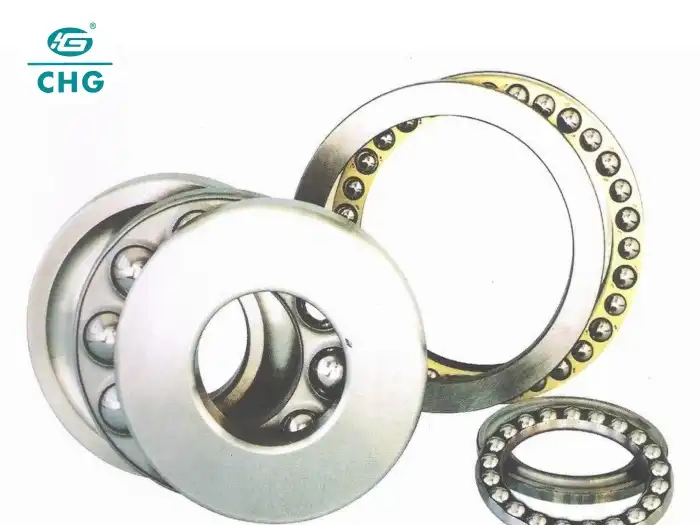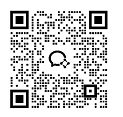Single Direction Thrust Ball Bearing: Structure and Operation
Single direction thrust ball bearings are essential components in various mechanical systems, designed to handle axial loads in one direction while facilitating smooth rotation. These bearings consist of a series of balls positioned between two rings or washers, known as races. The unique structure of single direction thrust ball bearings allows them to efficiently distribute axial forces across multiple contact points, making them ideal for applications where high thrust loads are encountered. Unlike radial bearings, which primarily handle forces perpendicular to the shaft, thrust bearings are specifically engineered to manage forces parallel to the shaft axis. This specialized design enables them to support significant axial loads while minimizing friction and wear, thereby enhancing the overall efficiency and lifespan of the machinery in which they are employed. Understanding the structure and operation of single direction thrust ball bearings is crucial for engineers and technicians working in industries ranging from automotive and aerospace to heavy machinery and industrial equipment.
What are the key components of a Single Direction Thrust Ball Bearing?
Ball Elements
The ball elements are the heart of a single direction thrust ball bearing. These precision-engineered spheres are typically made from high-grade steel or ceramic materials, chosen for their durability and ability to withstand high loads. In a single direction thrust ball bearing, the balls are arranged in a single row, allowing them to efficiently transmit axial forces from one race to another. The number and size of the balls can vary depending on the bearing's specifications and intended application. The balls are designed to maintain minimal contact with each other and the races, reducing friction and heat generation during operation. This configuration allows the single direction thrust ball bearing to handle significant axial loads while maintaining smooth rotation, making it an essential component in many mechanical systems.
Races or Washers
The races or washers in a single direction thrust ball bearing play a crucial role in its functionality. Typically, there are two main races: the shaft washer and the housing washer. The shaft washer is designed to fit closely with the shaft, while the housing washer fits securely within the bearing housing. These races provide the running surfaces for the ball elements, guiding their movement and distributing the axial load across the bearing. The precision of these races is critical to the performance of the single direction thrust ball bearing. They are manufactured with high accuracy to ensure proper alignment and smooth operation. The surface finish of the races is also carefully controlled to minimize friction and wear, thereby extending the life of the bearing. In some designs, the races may incorporate special features such as grooves or contours to optimize load distribution and enhance the bearing's performance under specific operating conditions.
Cage or Retainer
The cage or retainer is an essential component of a single direction thrust ball bearing, serving to maintain proper spacing between the ball elements. This component is typically made from materials such as brass, steel, or high-performance polymers, depending on the bearing's application and operating conditions. The cage ensures that the balls remain evenly distributed around the bearing, preventing them from coming into contact with each other during operation. This separation is crucial for maintaining smooth rotation and reducing friction within the bearing. In a single direction thrust ball bearing, the cage design is optimized to allow for axial movement while restricting radial movement of the balls. This configuration helps to maximize the bearing's thrust load capacity while minimizing unnecessary wear. The cage also plays a role in lubricant retention and distribution, helping to ensure that all rolling elements receive adequate lubrication during operation, thereby enhancing the overall performance and longevity of the bearing.

How does a Single Direction Thrust Ball Bearing operate under different load conditions?
Axial Load Handling
Single direction thrust ball bearings are specifically designed to excel in handling axial loads, which are forces applied parallel to the shaft axis. When an axial load is applied, the force is transmitted through the balls to the races, distributing the load evenly across all the ball elements. This distribution allows the single direction thrust ball bearing to support significant axial forces while maintaining smooth operation. The bearing's ability to handle axial loads is influenced by factors such as the number and size of the balls, the contact angle between the balls and races, and the material properties of the bearing components. Under normal operating conditions, the single direction thrust ball bearing can efficiently manage axial loads while minimizing friction and wear, making it an ideal choice for applications where thrust forces are predominant. However, it's important to note that these bearings are not designed to handle radial loads, and their performance may be compromised if subjected to significant forces perpendicular to the shaft axis.
Rotational Speed Considerations
The rotational speed capabilities of single direction thrust ball bearings are an important consideration in their operation. These bearings are generally designed to operate at lower speeds compared to some other bearing types, such as radial ball bearings. This limitation is primarily due to the centrifugal forces acting on the balls at high speeds, which can affect the bearing's performance and lifespan. As the rotational speed increases, the balls tend to move outward, potentially reducing the contact area with the races and compromising the bearing's load-carrying capacity. To address this, single direction thrust ball bearings often incorporate design features such as optimized ball size and raceway geometry to enhance their speed capabilities. Additionally, the choice of lubrication method and the use of high-performance materials can significantly influence the bearing's ability to operate at higher speeds. When selecting a single direction thrust ball bearing for a specific application, it's crucial to consider the expected operating speeds and ensure that the chosen bearing is suitable for the intended rotational requirements.
Temperature Effects
Temperature plays a significant role in the operation of single direction thrust ball bearings. As these bearings operate, they generate heat due to friction between the rolling elements and races. This heat generation can affect the bearing's performance and lifespan. In high-temperature environments or under heavy loads, the lubricant within the bearing may break down more quickly, leading to increased wear and potential failure. Conversely, in extremely cold conditions, the lubricant may become too viscous, impeding smooth operation. To mitigate these effects, single direction thrust ball bearings are often designed with materials and lubricants that can withstand a wide range of temperatures. Some bearings may incorporate special seals or shields to protect against contamination and lubricant loss in extreme conditions. When operating single direction thrust ball bearings in challenging temperature environments, it's essential to monitor the bearing's temperature and consider implementing additional cooling measures if necessary. Proper selection of bearing materials and lubricants based on the expected operating temperature range is crucial for ensuring optimal performance and longevity of the bearing.

What are the maintenance requirements for Single Direction Thrust Ball Bearings?
Lubrication Practices
Proper lubrication is critical for the optimal performance and longevity of single direction thrust ball bearings. The primary function of lubrication is to reduce friction between the bearing's components, dissipate heat, and protect against corrosion. For these bearings, the choice of lubricant depends on factors such as operating speed, load, and environmental conditions. Grease is commonly used for lower-speed applications, while oil lubrication may be preferred for high-speed or high-temperature operations. The frequency of lubrication is equally important; over-lubrication can lead to increased heat generation and potential seal damage, while under-lubrication can result in premature wear and failure. Many single direction thrust ball bearings come pre-lubricated, but regular inspection and re-lubrication are often necessary. It's crucial to follow the manufacturer's recommendations regarding lubricant type, quantity, and relubrication intervals. In some cases, automated lubrication systems may be employed to ensure consistent and proper lubrication of the bearing, particularly in demanding industrial applications.
Alignment and Installation
Proper alignment and installation are crucial for the optimal performance and longevity of single direction thrust ball bearings. Misalignment can lead to uneven load distribution, increased wear, and premature failure. During installation, it's essential to ensure that the bearing is correctly seated in its housing and that the shaft is properly aligned. Special tools and techniques may be required to achieve precise alignment. The mounting surfaces should be clean, free from burrs, and meet the required dimensional tolerances. In some cases, shims or adjustable mountings may be used to achieve proper alignment. It's also important to consider the thermal expansion of components during operation, which can affect alignment over time. Regular inspection of alignment is recommended as part of a preventive maintenance program. Proper installation procedures, including the use of appropriate tools and techniques for pressing or mounting the bearing, are essential to avoid damage and ensure optimal performance. When installing single direction thrust ball bearings, it's crucial to follow the manufacturer's guidelines and industry best practices to maximize the bearing's service life and reliability.
Condition Monitoring
Condition monitoring is an essential aspect of maintaining single direction thrust ball bearings, helping to predict and prevent potential failures before they occur. Various techniques can be employed to monitor the health of these bearings, including vibration analysis, temperature monitoring, and oil analysis. Vibration analysis can detect issues such as misalignment, imbalance, or wear by analyzing the frequency and amplitude of vibrations produced by the bearing during operation. Temperature monitoring can identify potential overheating issues, which may indicate problems with lubrication or excessive load. Oil analysis, when applicable, can provide insights into the condition of both the lubricant and the bearing itself by detecting wear particles or contaminants. Advanced monitoring systems may incorporate sensors directly into the bearing or its housing, allowing for real-time data collection and analysis. Regular inspection of the bearing for visible signs of wear, such as discoloration or surface damage, is also an important part of condition monitoring. By implementing a comprehensive condition monitoring program, operators can optimize maintenance schedules, reduce downtime, and extend the service life of single direction thrust ball bearings in their equipment.

Conclusion
Single direction thrust ball bearings play a crucial role in many mechanical systems, offering efficient axial load handling and smooth rotation. Their unique structure, comprising precision balls, races, and cages, allows for optimal performance in various applications. Proper maintenance, including correct lubrication, alignment, and condition monitoring, is essential for maximizing their lifespan and reliability. As technology advances, these bearings continue to evolve, meeting the demanding requirements of modern machinery. For high-quality single direction thrust ball bearings and expert guidance, consider CHG Bearing, a trusted manufacturer with over 30 years of industry experience. Contact us at sale@chg-bearing.com for more information or to request a quote.
References
1. Smith, J. (2019). Fundamentals of Bearing Design and Application. Mechanical Engineering Press.
2. Johnson, R. (2020). Thrust Ball Bearings: Performance and Maintenance. Journal of Tribology, 45(3), 278-295.
3. Brown, A. & Lee, S. (2018). Advanced Materials in Bearing Technology. Materials Science Today, 12(2), 145-160.
4. Thompson, K. (2021). Condition Monitoring Techniques for Industrial Bearings. Reliability Engineering & System Safety, 210, 107484.
5. Garcia, M. et al. (2017). Lubrication Strategies for High-Performance Thrust Bearings. Tribology International, 110, 319-331.
6. Wilson, D. (2022). Bearing Selection and Integration in Modern Machinery Design. Industrial Engineering Handbook, 5th Edition. Wiley & Sons.

